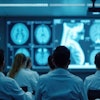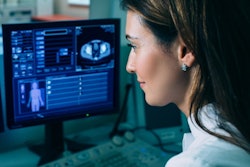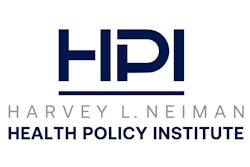Over 30 years ago, fascinated by the possibilities of what a "new" MRI machine could reveal about the brain, the Dalai Lama spent time with neuroscientists and radiologists to see whether meditation alters the brain in positive ways.
"He thought that it would be something that the MRI would uncover," recalled University of Pennsylvania Health System's senior vice president for data and technology solutions Mitchell Schnall, MD, PhD, to open Episode 13 -- Part 1 of a two-part series -- of AuntMinnie's Keeping Up with the Radiologists podcast.
University of Pennsylvania was early in adopting high-field MRI -- 1.5 tesla at the time -- and the Dalai Lama wanted to see what it was all about, according to Schnall, who has lived the history of radiology during his time at Penn.
"In a way, [the Dalai Lama] was ahead of his time," Schnall said, adding that in earlier days, "in the early 80s, there was a lot of controversy over field strength ... that 1.5 tesla was too high a field."
Yet, a University of Pennsylvania hospital had a 1.5 tesla, and the controversy would die down. Penn would also pioneer with General Electric (GE) in the company's Schenectady, NY, R&D laboratory, Schnall explained. Those were the days when radiologists played a role in building the hardware.
"The industry-academia partnership was truly a kind of synergy," added co-host Saurabh (Harry) Jha, MD. "Very intimate" was the relationship, according to Schnall, who was a resident at that time but achieved faculty status in 1990. He eventually served two terms as chair of radiology in the Perelman School of Medicine before taking on his new role overseeing data and technology solutions a year ago.
"It was hard to know where Penn ended and GE began and vice versa," he recounted. The rest is for you to hear for yourself in the first segment of this episode. Schnall and Jha described how GE would grow to a multimillion-dollar scale and magnitude. The Penn relationship changed, and radiology was on the verge of accelerating.
In the here and now, three key questions are posed in this episode:
Why can't we just hire more radiologists?
How should utilization be managed?
Are the fundamentals of medical practice moving in the right direction?
"Particularly as we see more and more of what I call 'flipping of the paradigm' -- where diagnostics are done upfront to see what specialist the patient needs to see, rather than diagnostics done after they see a specialist who's a gatekeeper to a sophisticated diagnostic," Schnall noted. "We're creating high-medical-utilization populations."
Listen for more details, including the discussion of the emergence of low-cost providers, such as radiology extenders, and what they can and cannot do. This episode suggests the future of the radiologist's role is to be determined.
What are the safeguards once the radiology department doors are opened to nonphysicians and nonradiologists?
Will radiologists be personally responsible for every word and every pixel in their reports?
What is the role of radiologists going forward?
"We're not involved very much anymore in the generation of images," Schnall explained during this episode. "We still provide some oversight here and there ... but not the way we did. Our 'role per pixel' will go down, but there's still a large role for us."
Schnall predicted that radiologists will spend more time managing quality systems, the most sophisticated diagnostic systems, and the most complex cases.
However, "there is this strong belief that every image that is produced must have a final attending [a board-certified radiologist in the U.S.] sign off at the end," Jha said, although that is not the case in other countries, he pointed out.
"I would argue that will be true going forward," Schnall said. "The question is what that board-certified radiologist's role is in generating that report."
Radiologists can learn from pathology laboratory management, according to Schnall. It's especially important in this new era of private equity and physician extenders inching into practice.
Also, radiologists, who have long been crunching their worklists, should begin considering "systems" thinking, according to Schnall, who recommended taking a small part of your portfolio, thinking about a different system, building around it, and then learning from test implementations.
Discussion of radiology extenders turns to sensible regulation to open the final segment of the episode. Fully autonomous and semiautonomous systems in AI and quality systems round out the program, which ends on a note ripe for debating.
"We talked about the laboratory pathologist," Schnall said. "If we think of our systems as assays, we need a similar framework for quality [as the Clinical Laboratory Improvement Amendments (CLIA)] that isn't just outsourced to our manufacturers but is something that independently we and the manufacturers partner on applying, to ensure that we can attest and sign off that that value is accurate, even if we didn't look at every pixel.
"This is an expertise radiologists need to have," Schnall continued. "We need quality systems that allow us to monitor these systems to ensure that our implementation is appropriate. Although industry has been afraid of this because it's complicated, I think this will be enabling."
Listen to the full episode now.
More impressions:
{00:59:00} The Dalai Lama
{03:59:06} 1.5-tesla scanner
{05:08:01} GE partnership
{11:04:09} Corporatization
{14:27:15} Hire more radiologists
{18:48:03} Single-payer system
{21:46:12} Managing utilization
{23:58:15} Flipping the paradigm
{25:26:09} Creating high-medical-utilization populations
{26:52:20} Low-cost providers
{35:12:01} Long-run strategy and safeguards
{37:17:18} Radiologists' role going forward
{41:56:05} Pathology laboratory management
{45:27:21} Systems thinking
{49:54:15} Quality systems management
Featured:
Mitchell Schnall, MD, PhD, is a physician at Penn Medicine in its abdominal imaging services program. Schnall served as chair of the department of radiology and the Eugene P. Pendergrass Professor of Radiology at the Perelman School of Medicine, before taking on the role of senior vice president for data and technology solutions for the University of Pennsylvania Health System in 2024. Schnall still serves as group co-chair of the ECOG-ACRIN Cancer Research Group since its founding in 2012. He is an international leader in translational biomedical and imaging research, working throughout his career across the interface between basic imaging science and clinical medicine to ensure effective integration of radiology research with other medical disciplines.
Saurabh (Harry) Jha, MD, is an associate professor of radiology at the Hospital of the University of Pennsylvania. Jha obtained a master’s degree in health policy research from the Leonard Davis Institute at the University of Pennsylvania. He earned his medical degree from the United Medical and Dental Schools of Guy’s, King’s, and St. Thomas’ Hospitals. Jha developed Value of Imaging, a set of radiology educational resources.
This episode of Keeping Up With the Radiologists is brought to you by AuntMinnie.com in collaboration with Penn Radiology. The series is also available on Spotify, YouTube Music, and Apple Podcasts. Check back for new episodes!




















